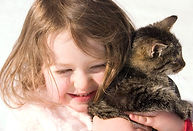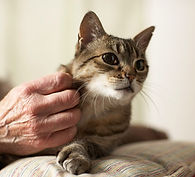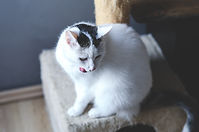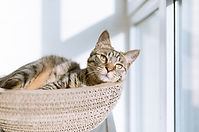Health Benefits Of A Natural Raw Food Diet In Cats





At Priority Pet Boarding Services Inc. we provide cat boarding services in the Ottawa and Toronto region but we also pride ourselves on providing the best quality care possible. Which includes providing our clients with scientific back studies to help our feline friends live a long and healthy life. Health benefits of a raw cat food diet includes.
-
Increased energy level
-
Prevent dehydration
-
Prevent the occurrence of UTI & kidney stones
-
Improved gastrointestinal track
-
Decreased risk of feline diabetes
-
Shiny coat and minimal hairballs
-
Better weight management
-
Money savings with less vet bills
-
An overall healthier, happier cat!
The Science Behind A Raw Food Diet
Cats have short gastrointestinal tracts that have a high acidic content; designed to break down raw meat. As humans, we have a longer gastrointestinal absorption process which increases the risk of humans acquiring food poisoning because bacteria can proliferate. Cats have a 12-hour absorption period which is a natural occurring property that protects them from e-coli and salmonella. In the wild, cats often eat the entire animal including the bones, fat, cartilage, muscles and skin. Bones provided a plethora of calcium necessary for strong bones and teeth. Bones also act as a natural toothbrush for cats cleaning the teeth.
The Dangers Associated With Dry Kibble
Dry kibble increases the risk of obesity, diabetes, urinary tract infections and dehydration. Cats only have one enzyme that can break down carbohydrates. Their bodies are not designed to be able to process carbohydrates like humans. The major concern with dry kibble is that it contains mostly starch and carbohydrates. Carbs get converted into sugar causing an increased risk of your cat developing diabetes.
It also causes dehydration in your cat which can increase the risk of UTIs and other gastrointestinal issues. Cats are very sensitive to dehydration and feeding them dry kibble loaded with carbs increases dehydration. Cats naturally do not drink a lot of water as they don’t have the same salivary glands as humans or dogs to notify them that they are thirsty. They consume most of their water from consuming others animals in the wild.
For example, a mouse contains approximately 65% to 75% moisture.
The source of protein matters and in dry kibble they have a blended source of protein from animals and plant-based protein. A cat’s natural diet consists of animals they catch in the wild such as rodents. These animals contain less than 2% carbohydrates.
Dry cat food, depending upon the manufacturer, can contain anywhere between 25% and 50% carbohydrates which is a staggering number (considering that cats don’t have the enzyme amylases which humans have). Amylases is a critical enzyme that aids in the breakdown of carbohydrates in humans; thus increasing the risk of obesity and diabetes in cats.
The Real Truth Behind Kibble
When kibble is initially manufactured your furry friend would have no interest in the product. It needs to be sprayed with flavorings, preservatives, additives and unique odors to entice your cat to consume it. Cats often over-eat due to the poor nutritional value in dry cat food. Another factor that decreases the nutritional value of kibble is the bio-availability of the nutrients. Cat kibble is processed via a heating mechanism and then dried. During the heating process, essential nutritional value is lost.
Benefits Of Providing A Natural Raw Food Diet
Natural raw food is very dense in nutrients and is loaded with all the essential amino acids your cat needs to thrive. It can aid in weight loss if your cat has obesity issues due to your cat needing to consume less calories to obtain more nutritional value thanks to the density of raw food.
Raw food improves cats' energy, digestion and promotes better urinary health. As a cat owner, before I became knowledgeable about the importance of a raw food diet I fed my cats a combination diet of dry cat food and Purina wet food. My cats struggled with urinary crystals, which is a very common occurrence in the feline community.
We had to take our cat, Howard, to the vet where he was diagnosed with severe urinary crystals. We were provided with antibiotics for treatment. Before he was diagnosed with the crystals we were very concerned about his health because he would urinate on the bed and other areas outside of his litter box, which is a sign that a cat might have a urinary issue. Since switching him to a raw food diet he has not had a single urinary issue.
An unknown benefit of raw food is that their urine may not smell as strong. Cats naturally have a strong odor to their urine to due a higher concentration count which enables them to stay hydrated. Feeding a cat, a natural raw food diet will aid in hydration and hopefully make your litter clean up a lot less smelly.
Your cats’ stool can also improve by switching to a natural raw diet. Normal cat fecal matter should be a hard stool without much odor and/or diarrhea. When you switch to a raw diet you may notice your cats' bowel movements have decreased to once a day or once every two days; which is a benefit for the cat owner because it saves on litter/having to clean the litter box as often.
In conclusion, a final benefit of a raw diet is your cat could have a healthier coat with less shedding and fewer hairballs. We all love our animals but if we could reduce the amount of unwanted hair in our home & reduce the amount of times our fur babies vomit due to hairballs, why not try? I think it’s a great idea!
As a pet care provider it is important to be familiar with cats biology in order for them to have a well balanced diet. If you have any other questions about the health benefits of natural raw food feel free to send me an email and I will personally get back to you.
Academic Citations
Peter J. Markwell, C. Tony Buffington, and Brigitte H. E. Smith, "The Effect of Diet on Lower Urinary Tract Diseases in Cats," The Journal of Nutrition 128, no. 12, December 1998, 2753S-2757S.
J. S. Rand, L. M. Fleeman, H. A. Farrow, D. J. Appleton, and R. Lederer, "Canine and Feline Diabetes Mellitus: Nature or Nurture?," The Journal of Nutrition, August 2004.
Ellen S. Dierenfeld, PhD, Heather L. Alcorn, BS, and Krista L. Jacobsen, MS, "Nutrient Composition of Whole Vertebrate Prey (Excluding Fish) Fed in Zoos," 2002.
Michael S. Hand, DVM, PhD; Craig D. Thatcher, DVM, MS, PhD, Rebecca L. Remillard, PhD, DVM, and Philip Roudebush, DVM, Small Animal Clinical Nutrition, 4th ed. Walsworth Publishing Company, 2000, 1075, 1077.
Peter J. Markwell, C. Tony Buffington, and Brigitte H. E. Smith, "The Effect of Diet on Lower Urinary Tract Diseases in Cats," The Journal of Nutrition 128, no. 12, December 1998, 2753S-2757S
.
Susan Donoghue and Janet M. Scarlett, "Diet and Feline Obesity," The Journal of Nutrition 128, no. 12, December 1998, 2776S-2778S.
Christopher S. Cowell, Neil P. Stout, Mark F. Brinkman, Edward A. Moser, and Stephen W. Crane, "History of Pet Food Manufacture in the United States," Small Animal Clinical Nutrition, 4th ed. Walsworth Publishing Company, 2000, 132-134.
Lisa A. Pierson, DVM, "We Are Feeding Cats Too Many Carbohydrates."
Kymythy R. Schultze, CN, CNC, Natural Nutrition for Cats, Hay House, Inc., 2008, 29.
JG Morris, "Idiosyncratic Nutrient Requirements of Cats Appear to be Diet-induced Evolutionary Adaptations," Nutrition Research Reviews 15, no. 1, June 2002, 153-68.
C Zambori, E Tirziu, I Nichita, C Cumpanasoiu, RV Gros, M Seres, B Mladin and D Mot, "Biofilm Implication in Oral Diseases of Dogs and Cats," Scientific Papers: Animal Science and Biotechnologies 45, no. 2, 2012.
Maxwell C. K. Leung, Gabriel Díaz-Llano, and Trevor K. Smith, "Mycotoxins in Pet Food: A Review on Worldwide Prevalence and Preventative Strategies," Journal of Agricultural and Food Chemistry 54, 2006, 9623-9635.
"Update: Recall of Dry Dog and Cat Food Products Associated with Human Salmonella Schwarzengrund Infections – United States, 2008," Morbidity and Mortality Weekly Report, Centers for Disease Control, ovember 7, 2008.
. J. S. Rand, L. M. Fleeman, H. A. Farrow, D. J. Appleton, and R. Lederer, "Canine and Feline Diabetes Mellitus: Nature or Nurture?," The Journal of Nutrition, August 2004





















